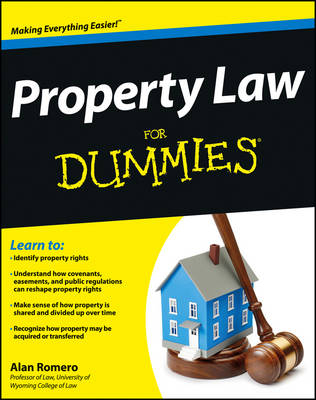
Property Law For Dummies
For Dummies (Verlag)
978-1-118-37539-6 (ISBN)
The easy way to make sense of property law Understanding property law is vital for all aspiring lawyers and legal professionals, and property courses are foundational classes within all law schools. Property Law For Dummies tracks to a typical property law course and introduces you to property law and theory, exploring different types of property interests—particularly "real property."
In approachable For Dummies fashion, this book gives you a better understanding of the important property law concepts and aids in the reading and analysis of cases, statutes, and regulations.
Tracks to a typical property law course
Plain-English explanations make it easier to grasp property law concepts
Serves as excellent supplemental reading for anyone preparing for their state's Bar Exam
The information in Property Law For Dummies benefits students enrolled in a property law course as well as non-students, landlords, small business owners, and government officials, who want to know more about the ins and outs property law.
Alan Romero is a professor of law and Director of the Rural Law Center at the University of Wyoming College of Law. He's been teaching Property Law and related courses at various law schools since 1998.
Introduction 1
About This Book 1
Conventions Used in This Book 2
What You’re Not to Read 2
Foolish Assumptions 2
How This Book Is Organized 3
Part I: Introducing Property Law 3
Part II: Understanding Real Property Rights 3
Part III: Looking at Shared and Divided Property Ownership 4
Part IV: Acquiring and Transferring Property Rights 4
Part V: The Part of Tens 5
Icons Used in This Book 5
Where to Go from Here 6
Part I: Introducing Property Law 7
Chapter 1: Getting the Lowdown on Property Law 9
Defining Property 9
Viewing property as legal rights 10
Categorizing property as real or personal 11
Describing the Duration and Sharing of Ownership 12
Acquiring Original Property Rights 13
Transferring Property Rights to Another 14
Chapter 2: Defining Property in Legal Terms 15
Distinguishing between Real and Personal Property 15
The real world: Land and buildings 16
A personal touch: Everything else that can be owned 16
Describing a Property Owner’s Rights 17
Possessing property 17
Using property 18
Excluding others from your property 18
Transferring property 18
Limiting a Property Owner’s Rights 19
Declaring default common law rules 19
Modifying property rights by contract 19
Publicly regulating property 20
Exploring Remedies for Violations of Property Rights 20
Common law forms of action 21
Legal and equitable remedies 22
Chapter 3: Considering Property Ownership 23
Defining Title 23
Acquiring Title 24
The first owners: Identifying original government title 24
Patents: Conveying government land to individuals 25
Acquiring private land for the public 26
Conveying title to private land during life 27
Transferring property by will 27
To the heirs: Distributing property by intestate succession 28
Acquiring title by taking possession 30
Selling property by judicial order 30
Sharing and Dividing Property Ownership 31
Defining present and future estates 32
Understanding undivided concurrent ownership 33
Part II: Understanding Real Property Rights 35
Chapter 4: Identifying Common Law Rights in Real Property 37
Nuisance Law: Enjoying Property without Unreasonable Interference 38
Determining whether an activity is a nuisance 38
Substantially harming the landowner 40
Remedying nuisances 40
Altering How Surface Water Drains 41
The reasonable use rule: Altering drainage reasonably 41
The common enemy rule: Protecting your own land 42
The civil law rule: Paying for any harm you cause 42
Regulating Water Rights 43
Claiming water from watercourses 43
Drawing water from underground 45
Extracting Oil and Gas from Underground 46
The rule of capture: “Go and do likewise” 47
Modifying the rule of capture 47
Avoiding Landslides and Subsidence: Supporting Land 48
Laterally supporting adjacent land in its natural state 49
Laterally supporting nearby land and improvements to land 50
Supporting land from beneath 50
No Trespassing! Excluding Others from Land 51
Considering what constitutes a trespass 51
Remedying trespasses 53
Using Airspace 53
Defining boundaries in the air 54
Using and protecting airspace 54
Chapter 5: Adjusting Rights by Private Agreement: Covenants 55
Introducing Land-Related Covenants 55
Enforcing a Running Covenant at Law 56
Determining intent for a covenant to run 58
Deciding whether a covenant touches and concerns the relevant land 59
Establishing vertical privity 61
Satisfying the horizontal privity requirement 63
Enforcing a Covenant in Equity 64
Enforcing covenants without privity 64
Requiring notice of the covenant 65
Remedying a breach of a covenant in equity 66
Burdens for the Benefit of All: Enforcing Implied Reciprocal Covenants 67
Inferring covenants from a common development plan 67
Implying intent to run 69
Giving notice of implied covenant 70
Interpreting Covenants 71
Amending Covenants 72
Terminating Covenants 73
Invalidating covenants that restrain alienation 74
Terminating a covenant because of changed circumstances 74
Waiving a covenant 75
Abandoning a covenant 76
Refusing to enforce unreasonable covenants 77
Analyzing a Covenant Dispute 78
Chapter 6: Giving Others the Right to Use Your Land: Easements 79
Grasping the Basics of Easements 79
Distinguishing affirmative and negative easements 80
Describing profits 81
Telling easements apart from licenses 81
Knowing what’s an easement and what’s a covenant 82
Creating Easements 83
Looking at express easements 83
Avoiding the statute of frauds 84
Implying easements three ways 86
Over time: Acquiring easements by prescription 89
Interference and Trespasses: Determining the Scope of Easements 92
Prohibiting interference by the servient owner 92
Preventing use that benefits nondominant land 93
Changing the type or purpose of use 94
Increasing the burden on the servient land 94
Maintaining the easement 95
Transferring and Dividing Easements 96
Sticking to the land: Transferring appurtenant easements 96
Dividing appurtenant easements 97
Transferring easements in gross 97
Dividing easements in gross 98
Terminating Easements 99
Terminating easements by express release or agreement 99
Ending easements by merging dominant and servient estates 100
Abandoning easements 100
Terminating easements by estoppel 101
Extinguishing easements by adverse use 102
Chapter 7: Zeroing In on Zoning 103
Discovering Who Typically Regulates Land Use 103
Regulating the Big Three: Use, Height, and Bulk 104
Protecting Nonconformities from New Zoning Restrictions 105
Permitting Conditional Uses 106
Avoiding Unnecessary Hardship with Variances 107
Demonstrating inability to reasonably use the land as zoned 108
Explaining why unique conditions require a variance 108
Avoiding alteration of the essential character of the locality 109
Amending Zoning 109
Requiring consistency with a comprehensive plan 110
Invalidating spot zoning 111
Chapter 8: Recognizing the Limits of Public Regulation 113
Looking for the Local Power Source: State Enabling Statutes 113
Explaining Property Deprivations: Substantive Due Process 115
Identifying a deprivation of property 115
Deciding whether a regulation is rational 116
Considering whether a regulation advances a public purpose 117
Compensating for Property Taken for Public Use 119
Compensating for condemnations 120
Figuring out when a regulation is a taking 121
Remedying regulatory takings: Paying up 125
Treating Similarly Situated Owners the Same: Equal Protection 125
Looking for rational differences in treatment 126
Remedying equal protection violations 128
Respecting Free Speech Rights 128
Regulating the land use effects of speech 129
Regulating the content of speech 129
Part III: Looking at Shared and Divided Property Ownership 131
Chapter 9: Dividing Ownership over Time: Estates 133
Introducing the Concept of Present and Future Estates in Land 134
Creating and Distinguishing the Present Estates 134
Creating a fee simple: No expiration 135
Dealing with the fee tail: Direct descendants 135
Limiting a present estate to life 136
Making Present Estates Defeasible: Conditional Endings 136
Determinable estates 137
Estates on condition subsequent 137
Estates subject to an executory limitation 137
Identifying Future Estates 138
Reversionary interests 139
Nonreversionary interests: Creating future estates in others 140
Describing the present estate the future estate holder will own 141
Distinguishing contingent and vested remainders 143
Interpreting grants to heirs 144
Restricting Certain Future Estates via Common Law Rules 146
Destroying contingent remainders 146
Invalidating restraints on alienation 147
Limiting Nonreversionary Interests: The Rule against Perpetuities 148
Understanding the interests subject to the rule 149
Determining the moment of vesting 149
Considering lives in being 150
Modifying the rule by statute 153
Transferring Present and Future Estates 153
Governing the Relationship between Owners of Present and Future Estates 154
Taking a closer look at waste 155
Forcing the judicial sale of real property in fee simple absolute 156
Chapter 10: Sharing Property: Concurrent Ownership 159
Concurrent Ownership: Owning the Same Property at the Same Time 160
Getting Familiar with Tenancy in Common 160
Creating a tenancy in common 161
Understanding fractional shares 161
Transferring one’s interest 162
Taking a Closer Look at Joint Tenancy 162
Overcoming the presumption of tenancy in common: Creating a joint tenancy 163
Satisfying the four unities: Time, title, interest, and possession 163
Understanding the right of survivorship 164
Severing the joint tenancy 165
Examining Tenancy by the Entirety 167
Creating a tenancy by the entirety 167
Restricting transfers by tenants by the entirety 168
Till death do us part? Terminating a tenancy by the entirety 169
Governing the Relationship among Cotenants 169
Using the concurrently owned property 169
Paying expenses 170
Renting the property 172
Acquiring interests in the property 172
Avoiding waste 173
Breaking Up: Terminating Concurrent Ownership by Partition 174
Partitioning voluntarily: Deciding to split property or proceeds 174
Compelling partition 175
Court orders: Dividing the property physically or by sale 175
Fair shares: Accounting among cotenants 177
Restraining partition 178
Creating and Owning Condominiums 178
Creating a condominium 178
Owning individual units 179
Owning common areas 180
Managing common areas 180
Chapter 11: Owning Property in Marriage 181
Protecting the Surviving Spouse 182
Yours, Mine, and Ours: Community Property Systems 183
Distinguishing separate property from community property 183
Transferring and dividing property 184
Protecting Homesteads 185
Dividing Property upon Divorce 186
Classifying property to be distributed 187
Valuing property to be distributed 188
Distributing property 188
Chapter 12: Leasing Property: Landlord-Tenant Law 191
Distinguishing Leaseholds from Other Interests 191
Licensing versus leasing 192
Comparing easements and leases 193
Creating and Differentiating the Four Types of Tenancies 193
Fixed-term tenancy 194
Periodic tenancy 194
Tenancy at will 195
Tenancy at sufferance 195
Possessing the Leased Premises 195
Delivering possession to the tenant 196
Covenanting not to disturb the tenant’s quiet enjoyment 197
Maintaining the Leased Premises 198
Understanding common law duties 198
Contracting to maintain the premises 198
Taking a look at constructive eviction 199
Warranting habitability of the premises 200
Protecting third parties from injury 203
Transferring the Leasehold 205
Restraining the tenant’s right to transfer 205
Transferring all or part of the tenant’s estate 207
Holding transferring tenants liable for subsequent breaches of the lease 208
Terminating the Leasehold 209
Terminating pursuant to agreement 209
Abandoning the leased property 210
Terminating the leasehold in other ways 211
Holding over after termination of lease 212
Applying and refunding security deposits 213
Evicting the Tenant 213
Evicting by self-help 214
Evicting by summary procedure 215
Part IV: Acquiring and Transferring Property Rights 217
Chapter 13: Acquiring Rights by Finding and Possessing Personal Property 219
Taking a Closer Look at Possession 219
Resolving Claims among Competing Possessors 220
Intending to control 221
Determining whether someone interfered with possession 221
Getting possession by trespassing 221
Becoming an Owner by Possessing Unowned Property 222
Taking Possession of Owned Property 223
Protecting the owner’s rights 223
Describing bailments and the possessor’s duties to the owner 224
Examining the Possessor’s Ownership Rights against Third Parties 225
Resolving Conflicts between a Finder and the Landowner 226
Keeping mislaid property with the landowner 226
Possessing embedded property 228
Recovering treasure trove 228
Discouraging wrongdoing by the finder 229
Reforming the Common Law by Statute 230
Finding the owner 230
Rewarding the finder if the owner shows up 230
Awarding the property to the finder if the owner doesn’t claim it 230
Determining when the lost property statute applies 231
Escheating property to the state 231
Chapter 14: Becoming an Owner by Adverse Possession 233
Getting Acquainted with Adverse Possession 233
Clearing up ownership on the ground 233
Applying the statute of limitations to ejectment 234
Exploring the Elements of Adverse Possession 236
Element #1: Actually Possessing the Property 237
Defining actual possession 237
Determining the scope of possession 238
Possessing under color of title 239
Paying taxes 239
Element #2: Possessing Exclusively 239
Element #3: Possessing Openly and Notoriously 240
Element #4: Possessing Adversely 241
Possessing by right rather than permission 241
Using the property as an owner 242
Element #5: Possessing Continuously and without Interruption 243
Defining continuous possession 243
Interrupting possession 244
Element #6: Possessing for the Statutory Period 245
Determining the required period 245
Combining periods of possession 245
Understanding Title by Adverse Possession 246
Quieting adverse possession title 246
Identifying the interests affected 247
Chapter 15: Contracting to Sell Land 249
Creating an Enforceable Contract to Sell Real Property 250
Requiring a signed writing 250
Identifying essential elements of a writing 251
Amending or rescinding the purchase agreement 252
Making an exception when an oral agreement is partly performed 252
Specifying Deadlines for Performance 254
Remedying an immaterial breach of a deadline 254
Remedying a material breach of a deadline 255
Conditioning the Parties’ Obligations to Perform 257
Tendering the deed and purchase price 258
Requiring marketable title 258
Obtaining financing 263
Considering other conditions 264
Managing the Risk of Loss 265
Allocating risk by equitable conversion 266
Contracting about risks 267
Insuring against risks 267
Remedying Breaches of Contract 268
Calculating damages 269
Liquidating damages 269
Specifically performing the contract 270
Disclosing Latent, Material Facts 270
Implicitly Warranting Workmanship and Habitability 271
Chapter 16: Conveying Title by Deeds 273
Merging a Purchase Agreement with a Deed 273
Recognizing the Formal Requirements for a Deed 275
Identifying the parties 275
Identifying the land 275
Expressing intent to convey 279
Signing the deed 280
The Handoff: Delivering and Accepting a Deed 280
Performing acts intended to make a deed effective 280
Delivering by escrow 281
Delivering by escrow at death 283
Accepting delivery of a deed 283
Warranting Title in a Deed 283
Covering the various covenants 284
Distinguishing present and future covenants 286
Limiting or omitting warranties: Distinguishing types of deeds 289
Remedying breaches of title covenants 292
Chapter 17: Recording Title 295
Understanding Priority Disputes 295
Recording Documents 296
Identifying recordable documents 297
Complying with conditions for recording 298
Using Indexes to Find Recorded Documents 298
Distinguishing the Three Types of Recording Statutes 300
Determining Whether an Interest Is Recorded 301
Recording a document improperly 301
Being unable to find a recorded document 301
Paying Value for Property Interest 303
Taking Property Interest without Notice 305
Actual knowledge 305
Constructive notice 306
Inquiry notice 308
Protecting Subsequent Purchasers from Unlikely Claims 308
Curing defects by title curative acts 309
Eliminating specific old interests 309
Applying marketable title acts 310
Chapter 18: Mortgaging Real Property 311
Introducing Mortgages and Deeds of Trust 312
Possessing the Property before Foreclosure 312
Taking possession 313
Appointing a receiver 313
Selling Property in Foreclosure 315
Curing default or exercising equity of redemption 315
Extinguishing junior interests 317
Distributing the proceeds of a foreclosure sale 318
Recovering deficiency from borrower 320
Protecting Mortgagor by Statute 320
Anti-deficiency statutes 321
One-action statutes 322
Statutory rights of redemption 322
Transferring Mortgaged Property 324
Restricting transfer 324
Assuming mortgage debt 325
Enforcing a mortgage against the transferor 325
Transferring Mortgage 326
Part V: The Part of Tens 327
Chapter 19: Ten Notable Property Cases 329
Spur Industries, Inc V Del E Webb Development Co 329
Tulk V Moxhay 330
Sanborn V Mclean 331
Village of Euclid V Ambler Realty Co 332
Penn Central Transportation Co V City of New York 333
Lucas V South Carolina Coastal Council 334
Javins V First National Realty Corp 335
Armory V Delamirie 336
Pierson V Post 337
Stambovsky V Ackley 338
Chapter 20: Ten Common Mistakes in Applying Property Law 339
Misapplying the Rule against Perpetuities 339
Mislabeling Present and Future Estates 340
Misunderstanding Hostility 341
Considering the Intent to Create a Covenant Rather than Intent to Run 342
Considering Only Notice of a Covenant’s Burden 343
Applying Estoppel or Part Performance without Evidence of an Agreement 343
Deciding a Joint Tenancy Exists without the Four Unities and Express Intent 344
Applying the Equitable Conversion Doctrine Where It Doesn’t Apply 344
Failing to Identify the Landlord’s Wrongful Act in a Constructive Eviction 345
Applying Purchase Agreements after Closing and Deeds before Closing 346
Chapter 21: Ten Property Subjects Commonly Tested in Bar Exams 347
Purchase Agreements 348
Mortgages 348
Deeds 348
Recording Acts 348
Landlord-Tenant Law 349
Estates 349
Concurrent Ownership 349
Covenants 349
Easements 350
Adverse Possession 350
Index 351
| Sprache | englisch |
|---|---|
| Maße | 185 x 231 mm |
| Gewicht | 522 g |
| Themenwelt | Recht / Steuern ► EU / Internationales Recht |
| Recht / Steuern ► Privatrecht / Bürgerliches Recht ► Sachenrecht | |
| ISBN-10 | 1-118-37539-4 / 1118375394 |
| ISBN-13 | 978-1-118-37539-6 / 9781118375396 |
| Zustand | Neuware |
| Haben Sie eine Frage zum Produkt? |
aus dem Bereich


